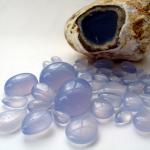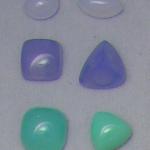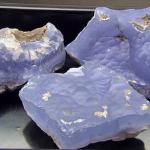
Classes- Alabama
- Alaska
- Arizona
- Arkansas
- California
- Colorado
- Connecticut
- Delaware
- Florida
- Georgia
- Hawaii
- Idaho
- Illinois
- Indiana
- Iowa
- Kansas
- Kentucky
- Louisiana
- Maine
- Maryland
- Massachusetts
- Michigan
- Minnesota
- Mississippi
- Missouri
- Montana
- Nebraska
- Nevada
- New Hampshire
- New Jersey
- New Mexico
- New York
- North Carolina
- North Dakota
- Ohio
- Oklahoma
- Oregon
- Pennsylvania
- Rhode Island
- Tennessee
- Texas
- Utah
- Vermont
- Virginia
- Washington
- West Virginia
- Wisconsin
- Wyoming
| Hardness : 7 Specific Gravity : 2.61 Refractive index : 1.53 - 1.5 Doubly Refracting (bi-refraction) : 0.004 Chalcedony, the beautifully colored micro crystalline quartz that could be precisely carved into seals and amulets, was a treasured gem of the ancient world. No important Roman would be without a seal or signet ring carved in this fine and durable material. The Victorians, too, prized chalcedony for carved cameos and intaglios: its fine texture allows for delicate and intricate workmanship. Jewelry designers today love its glowing translucent tones and its availability in a wide range of colors and shapes, including carvings. Varieties of chalcedony show an amazing variety of colors and patterns. The translucent stripes and bands of agates, the rich opaque green and brown of fine-grained jasper, the plant like forms of moss agate, the green and red pattern of bloodstone, the rich translucent orange-red of carnelian and apple-green of chrysoprase, and the opaque black of onyx are all faces of the versatile quartz gem. Chrysoprase, a bright apple green translucent chalcedony, is the most valued variety of chalcedony. It was a particular favorite of Frederick The Great of Prussia, who loved its bright green color. It can be seen today decorating many buildings in beautiful Prague, including the Chapel of St Wenceslas. Chrysoprase is found today mostly in Australia. Unlike most other green stones, which owe their color to chromium or vanadium, chrysoprase derives its color from nickel. Its bright even color and texture lends itself well to beads, cabochons, and carvings. Onyx was very popular with the ancient Greeks and Romans. The name comes from the Greek word onux , which means fingernail. The story is that one day frisky Cupid cut the divine fingernails of Venus with an arrowhead while she was sleeping. The fates turned the clippings into stone so that no part of the goddess would ever perish. Black isn't normally the color one associates with fingernails, but in Greek times, almost all colors of chalcedony from fingernail white to dark brown and black were called onyx. Later, the Romans narrowed the term to refer to black and dark brown colors only. Even in Roman times, the black color of onyx was usually enhanced by man. More than 2000 years ago, Roman historian Pliny described a traditional technique for darkening onyx that is still in use today. The onyx is soaked in sugar water, then placed in strong acid. After boiling for two hours, the acid eats away the sugar and water, leaving pure black carbon. Today cobalt dye is also used. Onyx which is reddish brown and white is known as sardonyx. Sardonyx was highly valued in Rome, especially for seals, because it was said to never stick to the wax. Roman General Publius Cornelius Scipio was known for wearing lots of sardonyx. Particular prized in the ancient world was the orange-red color of chalcedony known as carnelian. Mummies in ancient Egypt often wore necklaces with carved carnelian figures of the Gods, no doubt considered powerful amulets to protect the wearer during the journey to the spirit world. There is a long tradition of reverence for carnelian in the Muslim world because the prophet Mohammed wore a carnelian seal set in a silver ring. Napoleon wore a carnelian seal engraved with “The slave Abraham relying on the Merciful (God).” No gemstone is more creatively striped by nature than agate, chalcedony quartz that forms in concentric layers in a wide variety of colors and textures. Each individual agate forms by filling a cavity in host rock. As a result, agate often is found as a round nodule, with concentric bands like the rings of a tree trunk. The bands sometimes look like eyes, sometimes fanciful scallops, or even a landscape with dendrite trees. Agate was highly valued as a talisman or amulet in ancient times. It was said to quench thirst and protect from fevers. Persian magicians used agate to divert storms. A famous collection of two to four thousand agate bowls accumulated by Mithridates, king of Pontus, shows the enthusiasm with which agate was regarded. Agate bowls were also popular in the Byzantine Empire. Collecting agate bowls became common among European royalty during the Renaissance and many museums in Europe, including the Louvre, have spectacular examples. Bloodstone, green jasper dotted with bright red spots of iron oxide, was also treasured in ancient times and long served as the birthstone for March. This attractive chalcedony quartz is also known as Heliotrope because in ancient times polished stones were described as reflecting the sun: perhaps the appearance of the gem reminded the ancients of the red setting sun reflected in the ocean. Even today, finely powdered bloodstone is used as a medicine and aphrodisiac in India. Medieval Christians often used bloodstone to carve scenes of the crucifixion and martyrs, leading it to also be dubbed martyr's stone. The legend of the origin of bloodstone says that it was first formed when some drops of Christ's blood fell and stained some jasper at the foot of the cross. A beautiful example of carved bloodstone with the seal of the German Emperor Rudolf II can be seen at the Louvre museum in Paris. Durable and easy to care for, chalcedony has a hardness of 7 and enviable toughness even when carved in intricate designs. The seal rings worn by ancient Romans are still in fine shape today. Clean with mild dish soap and let dry. |
- Birth Stone Gems
- Wedding & Anniversary Gems
- How To Guides
- Fireable Gems
- Nonprofits and Guilds
- Gem Show
- Gem Stone Information
- ·Abalone
- ·Achroite (Tourmaline)
- ·Agate ( Chalcedony)
- ·Alexandrite
- ·Almandine ( Garnet )
- ·Amber
- ·Amethyst ( Quartz)
- ·Ammolite
- ·Andalusite
- ·Andradite Garnet
- ·Apatite
- ·Aquamarine ( Beryl )
- ·Aventurine ( Quartz )
- ·Azurite
- ·Benitoite
- ·Bloodstone ( Chalcedony )
- ·Brown Quartz ( Smokey Quartz )
- ·Calcite
- ·Carnelian ( Chalcedony )
- ·Cassiterite
- ·Celestine
- ·Cerussite
- ·Chalcedony
- ·Chatoyant Quartz
- ·Chrysoberyl
- ·Chrysocolla
- ·Chrysoprase (Chalcedony)
- ·Citrine ( Quartz )
- ·Coral
- ·Danburite
- ·Diamond
- ·Diopside
- ·Dioptase
- ·Dravite ( Tourmaline)
- ·Emerald ( Beryl )
- ·Enstatite
- ·Epidote
- ·Euclase
- ·Fire Agate (Chalcedony)
- ·Fluorite
- ·Gold
- ·Goshenite (Beryl)
- ·Grossular Garnet (Tsavorite Garnet)
- ·Gypsum
- ·Heliodor ( Beryl )
- ·Hematite
- ·Hessonite (Grossular Garnet)
- ·Imperial Topaz
- ·Indicolite ( Tourmaline)
- ·Iolite
- ·Ivory
- ·Jadeite
- ·Jasper (Chalcedony)
- ·Jet
- ·Kornerupine
- ·Kunzite
- ·Kyanite
- ·Labradorite
- ·Lapis Lazuli ( Lazurite)
- ·Lazulite
- ·Malachite
- ·Meerschaum
- ·Microcline
- ·Milky Quartz
- ·Moonstone
- ·Morganite ( Beryl)
- ·Nephrite ( Jade)
- ·Obsidian
- ·Oligoclase
- ·Onyx
- ·Opal
- ·Orthoclase
- ·Padparasha ( Corundum)
- ·Pearl
- ·Peridot
- ·Pink Topaz ( Mercury Myst Vapor )
- ·Plasma ( Chalcedony)
- ·Prase ( Chalcedony )
- ·Prehnite
- ·Pyrite
- ·Pyrope ( Garnet )
- ·Rock Crystal ( Quartz )
- ·Rubellite ( Tourmaline)
- ·Ruby ( Corundum)
- ·Sapphire ( Corundum)
- ·Sardonyx ( Chalcedony)
- ·Scapolite
- ·Schorl (Tourmaline)
- ·Shell
- ·Spessarite (Garnet)
- ·Sphalerite
- ·Spinel
- ·Spodumene (Hiddenite - Triphane)
- ·Tanzanite (Zoisite)
- ·Tektites ( Moldavite )
- ·Tiger Eye
- ·Titanite (Sphene)
- ·Topaz
- ·Turquoise
- ·YAG (Garnet)
- ·Zircon


